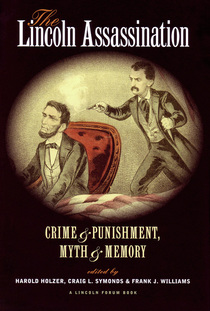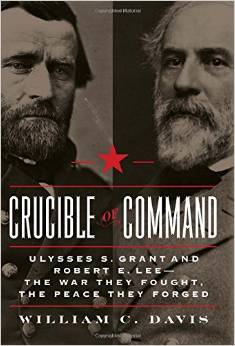The Lincoln Assassination: Crime & Punishment, Myth & Memory edited by Harold Holzer, Craig L. Symonds, & Frank J. Williams. Fordham University Press, 2010. Cloth, ISBN:0823232260 $29.00.
 Abraham Lincoln’s assassination on Good Friday in 1865 shocked the nation, elevated the fallen President to martyrdom, immediately inspired mythmakers, and intrigued historians for years. Contributors to The Lincoln Assassination: Crime and Punishment, Myth and Memory take readers back to the Civil War’s end and reveal how Lincoln’s funeral elicited both sorrow and even joy among some; how the trial of his assassins by military tribunal inspired legal questions; how Lincoln’s death necessitated loyalty among United States soldiers; and, how artists exaggerated the event in their work.
Abraham Lincoln’s assassination on Good Friday in 1865 shocked the nation, elevated the fallen President to martyrdom, immediately inspired mythmakers, and intrigued historians for years. Contributors to The Lincoln Assassination: Crime and Punishment, Myth and Memory take readers back to the Civil War’s end and reveal how Lincoln’s funeral elicited both sorrow and even joy among some; how the trial of his assassins by military tribunal inspired legal questions; how Lincoln’s death necessitated loyalty among United States soldiers; and, how artists exaggerated the event in their work.
Nineteenth-century Americans looked to Lincoln and his memory to explain their identity and values. The things for which Lincoln stood – democracy, the Union, and the self-made-man – have persisted into the present day thanks to the constant scholarly and public attention that Lincoln received immediately after he passed. As Harold Holzer notes, the Lincoln legend grew through the “public, judicial, and memorial reaction” to his death and continues to fascinate professional historians and the general public (3). But, as Richard Nelson Current points out, the real Lincoln is difficult to discern through the shadow of his legend. This book, however, with its focus on the perpetuated Lincoln myth through the recounting of his death and the obsession with the trial of the assassination conspirators, tells not only about the man himself, but also how he defined the American character and how he continues to influence American political values.
One of the central problems of the Lincoln legend that this volume remedies is the ease with which those recounting Lincoln’s death separated the fatal event from the broader historical context in which it occurred. This tendency, over time, has contributed to Lincoln’s status as a martyr. Articles by Richard E. Sloan, Thomas P. Lowry, and Harold Holzer and Frank J. Williams reveal the actual and imagined magnitude of the assassination. Sloan’s examination of Lincoln’s New York City funeral provides a glimpse of how the death of one man affected countless Americans as over 200,000 people participated in Lincoln’s funeral procession and public viewing in one city alone (86). The outpouring of grief that Americans demonstrated was mythical in and of itself and certainly contributed to Lincoln’s image as a martyr and to his looming legend.
Although the actual magnitude of the assassination and the nation’s consequent grief spoke for themselves, artists felt the need to embellish Lincoln’s death, as Harold Holzer and Frank Williams demonstrate. The authors draw attention to the role that artists played in shaping the “American collective memory” in the 1860s (11). Prominent American artists from Courier and Ives to John Henry Buford to foreign artists like Gostave May of Germany embellished the humble scene in which Lincoln died by depicting prominent spectators at his bedside and creating a dramatic scene worthy of a “dying hero” (17).
While articles by Sloan and Holzer and Williams reveal that the dominant reaction to Lincoln’s death was grief, Thomas Lowry demonstrates that a small number of Americans – not only in the South, but also in the Union Army – were elated at Lincoln’s death or thought that it an appropriate fate for such a divisive political figure. In the confusion that surrounded the Civil War’s end, however, the army’s punishment through imprisonment of soldiers, sailors, and civilians who celebrated Lincoln’s death reveals that loyalty was of the utmost importance just as it had been during the war. Lowry’s work ultimately shows that mourning, or at least not voicing approval of Lincoln’s assassination, was the position that the federal government supported and enforced through military law.
Federal officials also desired to avenge the crime. As Elizabeth Leonard, Edward Steers, Jr., Thomas Turner, and Frank J. Williams demonstrate, government officials, like Judge Advocate General Joseph Holt, Andrew Johnson, and Edwin Stanton, all ensured that justice was served to those responsible for the crime. Many Americans, like Joseph Holt, became obsessed with the idea that the assassination conspirators suffer just punishment for their crime in order to avenge the President’s death. Elizabeth Leonard uses Holt’s persistent quest to bring the conspirators to justice to demonstrate that many Americans believed that the conspiracy to kill the President was widespread and originated at the “highest levels of the Confederate power structure,” revealing the mistrust of Southerners to which Northerners clung in war’s aftermath (132). The trial of the Lincoln conspirators had many consequences, including the destruction of Holt’s political reputation and a flurry of legal questions surrounding the use of military trials to bring the conspirators to justice.
Frank Williams, Thomas Turner, and Edward Steers demonstrate, too, that military justice, while controversial, was a fitting means by which to try the conspirators. As Williams notes, even though Mary Surrat and Dr. Samuel Mudd appeared to some as “innocent victims” of the government’s desire for revenge, the Federal government had the Jurisdiction to employ military commissions in the case (140). Not only was the use of such commissions legal, they also, as Steers demonstrates, differed little from the procedures of civil law, thereby suggesting that the defendants would have been guilty regardless of the court in which they appeared.
Williams also reminds us that the use of military courts to try civilians is an issue that arouses heated debate even today. While the discussion of President George W. Bush and President Barack Obama’s use of military tribunals to try terror suspects is a departure from the book’s overall aim of capturing the American sentiment regarding Lincoln’s death in 1865, it is a clear reminder that in many ways, the American public is still reacting to the assassination itself and to the legal, social, and political dynamics that it inspired. In this regard, as Michael Kauffman notes, the trial testimony of the conspiracy defendants should not – and does not – serve as the final word on the assassination. The continued scholarly and public interest in Lincoln’s assassination suggests that there will not be a final word on his death or his legacy for years to come.
Angela M. Zombek is an Assistant Professor of History at St. Petersburg College in Clearwater, Florida.

